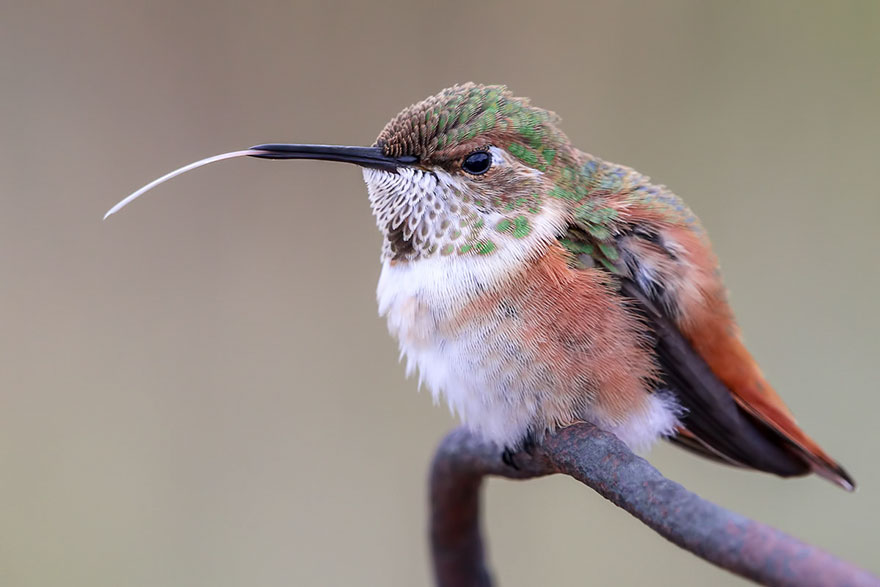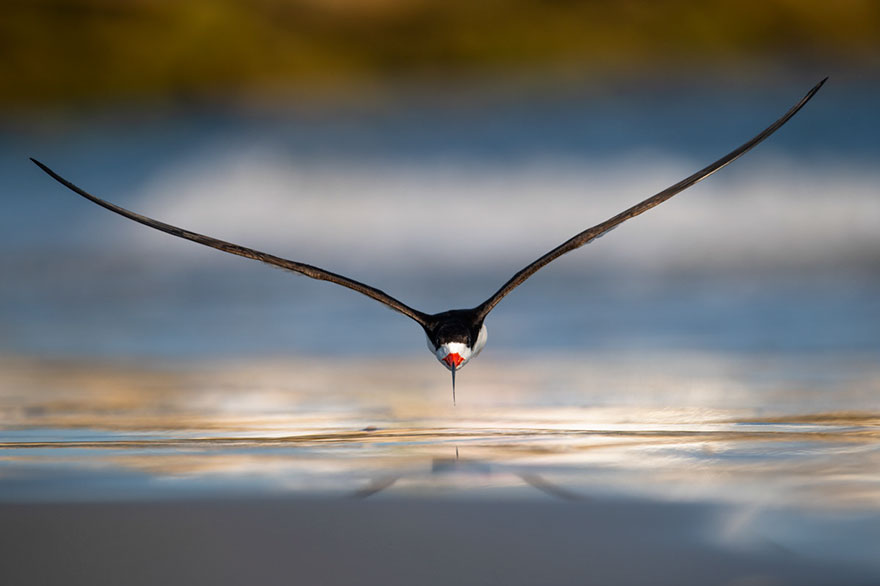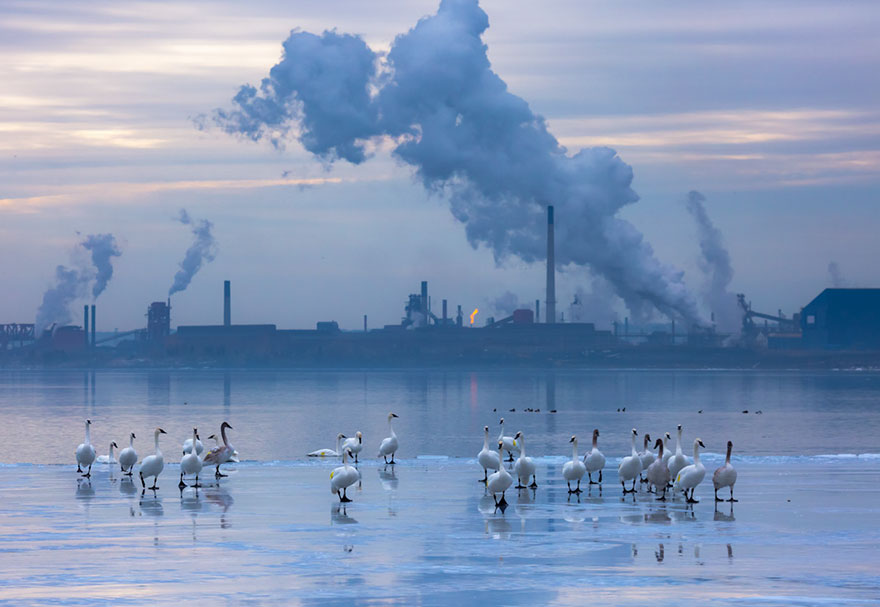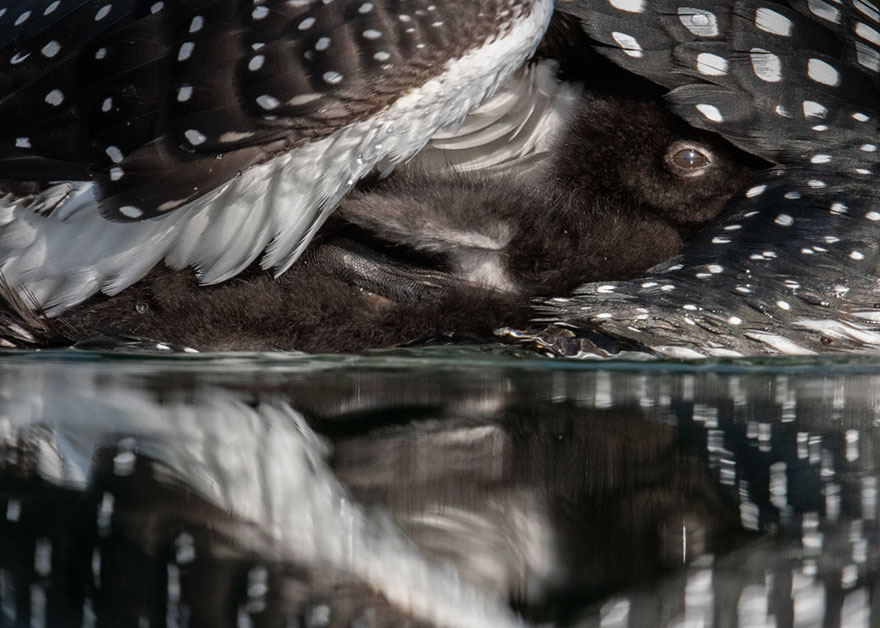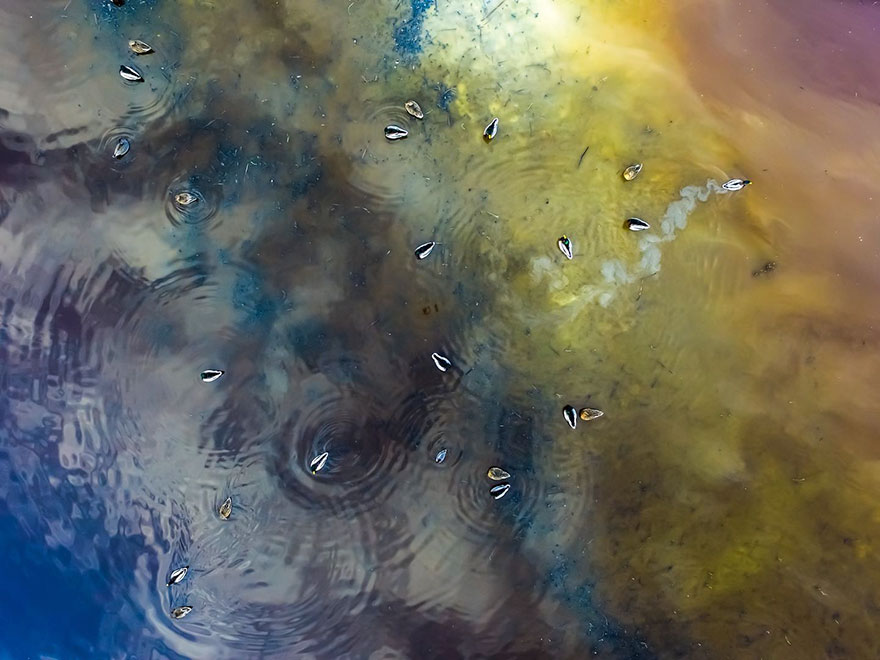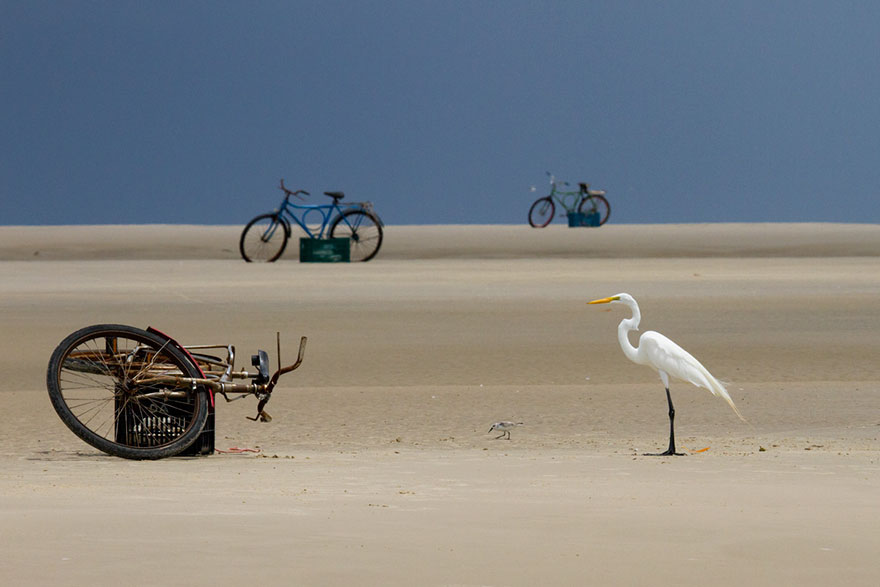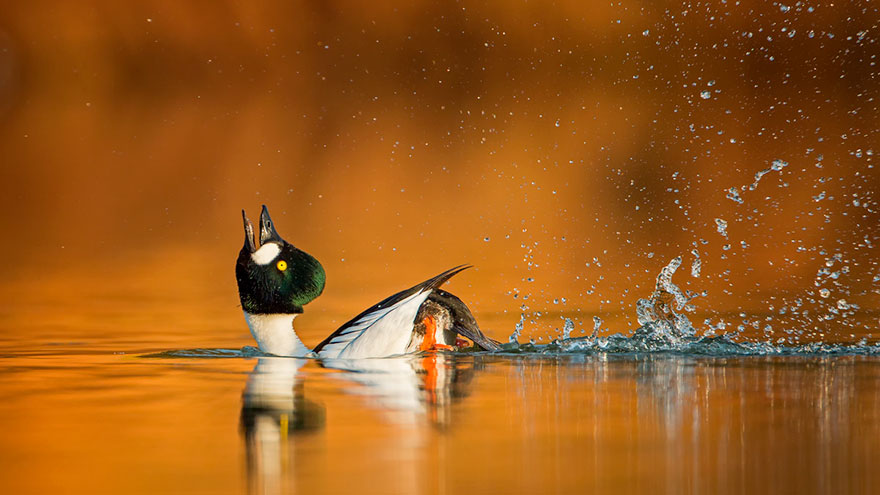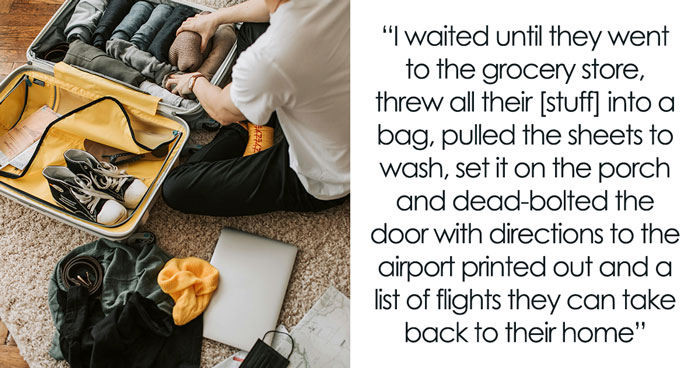The Bird Photographer of the Year is a bird photography competition held annually since 2016 where photographers from all over the world compete for the grand prize and the title of Bird Photographer of the Year. And now, after a whole year of waiting, the winners of this year's competition have finally been announced.
The winner of this year's Bird Photographer of the Year title and a £5,000 prize is British photographer Caron Steele and her majestic photograph of a Dalmatian Pelican on a frozen Lake Kerkini in Greece. Check out Caron's photograph and other category winners in the gallery below!
More info: Bird Photographer of the Year | Instagram | Twitter | Facebook
This post may include affiliate links.
Yashodhan Bhatia - Best Portrait - Honorable Mention
‘Those small dark profiles, flying with super-fast manoeuvres in the sky, are swifts or swallows. Identifying them is a challenge unless you have a good look at them. Of course they do differ, only slightly in size or in details of plumage. All of them are adapted for high speed flight, thanks to slender, streamlined bodies, short necks, long pointed wings and small beaks. These all adaptations are for hunting insects in mid-air at breakneck speeds. I found a small colony of Little Swifts under a bridge on a state highway and thought of spending time with them to get some unusual perspectives. It took me four sessions in two days and numerous pictures to get the desired result. I was amazed at how these tiny birds have truly mastered flight. While gliding, they continually change the shape of their wings, albeit very subtly, and optimize their aerodynamic performance to control lift, thrust, drag and what not.’
Caron Steele - Bird Photographer Of The Year
‘On arriving in Greece to photograph the Dalmatian Pelicans in their breeding plumage I discovered that Lake Kerkini, their favoured haunt, had frozen for the first time in 16 years; all the pelicans had flown off. Fortunately, a few holes started to thaw in the lake and the birds slowly began to return. Unused to the slippery icy surface of the lake they regaled us with hilarious antics as they slid across the lake surface trying to retain control as they took off and landed. I was lucky enough to capture one such rare moment when this magnificent pelican ran towards me across the ice at dusk before taking off. It was a truly unique experience, both magical and comical at the same time. And the image remains a moment of pure joy captured forever.’
In an interview with Bored Panda, Rob Read, the founding director and the coordinator of the competition said there were over 13,500 entries in this year's competition.
Of course, getting your picture picked as one of the winners is no easy task. "The images are chosen via a large panel of judges and are subject to two online scoring rounds followed by a round table meeting to discuss the finalists and to choose the winners," said Rob when asked how the winning photos are chosen.
Csaba Tokolyi - Attention To Detail - Silver
‘It had been a long night, lodged in a hide set up for nocturnal species. After those long dark hours packed with action photography the breaking dawn presented a real treat. A Little Egret in wonderful breeding plumage stopped by and was standing at close range in the golden light of dawn reflected on the water’s surface. The elongated scapular feathers covered the bird like a gown in the lovely morning light. Instead of using wide-angle, I looked for a composition with my telephoto lens to try to record a different kind of image.’
Chad Larsen - Garden And Urban Birds - Gold
‘My wife and I had been photographing Snowy Owls for a couple days during the Christmas Holidays in Saskatchewan. On this morning, I returned to the same area and could not believe what I was seeing... an all-white Snowy Owl on a quaint white church! Trying to focus on a white owl set against a very light backdrop proved to be very difficult. However, my biggest challenge was getting into a central position without disturbing this peaceful moment: I knew an opportunity like this might never happen again.’
Caron Steele, the winner of this year's competition, said she was delighted to be awarded the title."It is wonderful to receive such recognition for something I absolutely love doing," said the photographer in a press release.
Carol says she only took up photography seriously back in 2014 when she had gotten her first camera. Since then, she has been on a sharp learning curve. "I did a zoology degree at the University of Oxford, but then went on to pursue other things. Now I love being able to get back to nature and see things through the perspective of my camera," said the photographer. "I am so passionate about conservation and am keen to find an angle where I can help make a significant difference; winning this award has spurred me on to renew my efforts."
Cat Edwardes - Creative Imagery - Honorable Mention
‘I wanted to take a slightly different image of a hummingbird to capture the light through its delicate wings. I found a particularly good flower that would work in silhouette. In the end I had to take hundreds of images until I got the perfect wing position and a slight separation between the bird and the flower. This is all captured in-camera.’
Ben Andrew - Best Portrait - Silver
‘This image of a bold young Kingfisher was taken during the winter months. The bird spent time in the middle of a town centre, fishing around ornamental water gardens that are surrounded by shops, roads and a car park. The Kingfisher regularly spent time perched on railings waiting to plunge into the water below. This spot was right next to the bus stop, so I positioned myself looking along the railings and waited for a bus to arrive. Luckily the buses in the town are blue in colour perfectly matching the Kingfisher’s plumage. So it was just a matter of waiting and hoping a bus came along with its lights on while the bird was sitting there!’
"In today’s hectic life I think it is vital we strive to save the beautiful natural world around us, as ultimately I believe it will save us. Photography and being at one with nature brings a sense of calm, joy and appreciation that can strip away the stresses of life," added Carol. "I recommend this therapy to everyone. Save your planet and save your soul: pick up a camera and get out there today and be as free as a bird!”
Madeline Nolan - Young Bird Photographer Of The Year - Silver
‘My family and I travelled to Creede, Colorado. My mom had just got a new camera and a big lens. Every morning, I would wake up, borrow the equipment and take pictures of the hummingbirds in the national forest. Some days, I would shoot for hours. I was able to capture this adorable female Rufous Hummingbird sticking her tongue out! I had never seen that before. It was not easy to capture and I am thrilled I was able to get such a neat shot.’
Nikunj Patel - Birds In Flight - Gold
‘Black Skimmers are one of my favourite birds and I love spending time in the summer observing and photographing them. Skimmers have a light and elegant flight, with steady wingbeats. They fly low over water and dip their lower mandible just below the surface, feeling for tiny fish and snapping them up with deadly speed, and making high-speed turns in mid-flight. On a nice summer evening, I arrived at a colony of nesting seabirds on a beach to photograph Black Skimmers flying in, bringing fish for the new-born chicks. I decided to set up low on the beach as it would give me an eye-level perspective with the birds. A few skimmers had gathered at the edge of the shoreline and were having a vigorous bathing session. As some of them took off, I saw one flying low and straight towards me. Luckily, I was able to acquire focus, press the shutter and capture a beautiful image of the bird flying straight at me. Black Skimmers rely on open beaches for nesting and raising their young, with direct access to the water for feeding. Coastal development and our own love of the same beaches have left them with few safe places to nest. The image was captured in the summer of 2018 at Ocean City, New Jersey, USA. The Black Skimmer is an endangered species in the state of New Jersey.’
"‘Dancing on Ice’ is an image that had me leaping from my chair with joy the moment I saw it appear on my computer screen," commented Rob on the winning photograph. "All too frequently the judges see images where the photographers have fabulous photographic opportunities that they fail to make the most of. Lake Kerkini rarely freezes over and Caron certainly made the most of this virtually unique opportunity. Everything about this image is right, it is truly delightful in its near- perfection.”
Jozsef Gergely - Bird Behaviour - Silver
‘Recently I visited a fish-farm near Kanjiza in the northern Serbian province of Vojvodina. As you can imagine, the abundance of corralled fish acts like a magnet for fish-eating birds such as the Grey Heron. This particular individual caught my eye: despite its size and bulk it was doing an extremely good job balancing on one of the fishing nets. I love the ‘high key’ effect achieved by shooting into the light.’
Shane Kalyn - Birds In Flight - Honorable Mention
‘I was photographing a couple of Rufous Hummingbirds who were engaged in a mid-air battle with each other to claim a territory. As I watched, this particular male would always come and hover in the same spot, so I aimed the camera and waited. On this particular occasion he gave me (and the other male hummingbird in the area) a full display of his feathers.’
This is easily the best hummingbird photo I have ever seen! (My brother is a wildlife photographer, so I’ve seen lots.)
Pal Hermansen - Attention To Detail - Gold
‘This mature Goshawk was photographed while it visited a feeding place in the forest. Instead of taking standard images, showing the whole bird, I decided to put on a very long lens and try to pick out details in the feathers. When the feet appeared, I saw the image I had been dreaming of.’
Is it just me or does the plumage look like it's covered with hundreds of mini dive-bombing hawks???
Liron Gertsman - Birds In Flight - Bronze
‘Scattered throughout the Amazon basin are hundreds of clay licks where parrots, parakeets and macaws come to eat clay and neutralize the acidic fruits that they eat. Getting to the clay lick (and watering hole) where I took this photo required a regional flight, a three-hour boat ride upstream, and a short canoe ride to get to base camp. From base camp, it took another short boat ride and a 30 minute hike (a longer hike than usual due to low water levels in July 2017) each day to get to the clay lick. It took many hours of waiting over three days before we were treated to the sight of hundreds of Cobalt-winged Parakeets raining down on the forest floor. Seeing them and hearing the deafening roar of parakeet chatter was an experience I don’t think I’ll ever forget. After they drank the mineral rich-water and ate some clay, it was over; this photo captures the chaos as the parakeets took to the air, heading back to the canopy. I used a slow shutter speed to convey movement as the birds took to the air.
Ooo, I love this kid's work! He has been so talented from such a young age! I'd encourage you to look him up :)
Audun Lie Dahl - Creative Imagery - Bronze
‘Hornøya is a tiny island and boasts the northernmost bird cliffs in Norway; and each year thousands of Common Guillemots come here to breed. I have visited this place numerous times, and finally I had the backlighting conditions I had been dreaming about. I used the lens aperture in such a way as to create pleasing ‘bokeh’ of the birds, as well as impressions of light caused by the sun reflecting off the ocean behind the birds.’
Edwin Giesbers - Birds In The Environment - Silver
‘Most owl species lead a solitary life, but when autumn makes its appearance, Long-eared Owls are sometimes more gregarious. From September to April, some birds sleep in close proximity to one another during the daytime in so-called roost trees; in some cases these trees have been used for decades. Who knows, they could be in your neighbourhood because often these roost trees are located in residential areas. Trees like Beech and Silver Birch are used in autumn. But as these trees lose their leaves, the birds often move to a nearby Yew or fir where they are less noticeable than in a bare tree.’
Bence Mate - Bird Behaviour - Honorable Mention
‘Bird photographers rarely get the opportunity to shoot white birds in a white environment. I had planned for more than ten years to capture Great White Egrets in the snow, with snow clouds in the background so that their black legs and yellow beaks dominated the image. Lots of environmental factors needed to coincide at the same time for such an image to be possible. The European population of Great White Egrets is very resilient: in temperatures of -15° C they are protected by their thick plumage, while in temperatures as high as +40°C their colour reflects the sun’s rays.’
Hu Yi - Bird Behaviour - Bronze
‘This image shows two male Reeves’s Pheasants, performing an elaborate display that I refer to as their ‘dancing steps’. The behaviour is designed to attract the attention of the nearby female. The species is one of the most splendid and attractive of all protected birds in Xinyang City, Henan Province.’
Honestly looks like the bird on the left sent their mother, the bird in the middle, to beat up the bird on the right for making fun of them.
Pedro Jarque Krebs - Creative Imagery - Honorable Mention
‘I took this photo while on a visit to London Zoo, just at the moment the pelicans were being fed. Two zookeepers were stationed on either side of their pond and fed the pelicans alternately. As a result the three birds were obliged to run from one side to the other, making them work for their dinner. In addition to giving the pelicans a bit of healthy exercise, it meant that the keepers could ensure that the fish were distributed equally and fairly, and all three pelicans got a decent meal.’
Kathryn Cooper - Creative Imagery - Silver
‘I visited Bempton Cliffs in June 2018, a place where half a million seabirds gather; they are drawn by plentiful nesting sites located along a 17-mile stretch of cliffs that are up to 400 feet high. The sheer number of birds in the air is a true wildlife spectacle and difficult to depict in a photograph. This image is part of a larger creative project that combines my inquisitiveness for art, science and nature. My background in science and programming allows me to write my own bespoke algorithms to compress the time dimension of a video onto a single image. To give you a sense of scale, this image contains ‘bird tracks’ captured over a five second period.’
Wow, your dedication and hard work really paid off. That’s a fascinating image.
Arturo De Frias - Best Portrait - Honorable Mention
‘Last spring, I went for another visit to my beloved Arctic - to the Svalbard archipelago, a place that I love with a passion. There, I was honing a photography technique that could be called ‘extreme overexposure’. All you need is a white animal and a white background, and then dial-in extreme exposure compensation (+ four stops in this case). Of course then you need some patience. But the results are truly unique: you are left with a kind of pencil sketch, in which most details of the bird and the background disappear.’
Chris Gomersall - Garden And Urban Birds - Honorable Mention
‘Having spent the day watching and photographing a large flock of Starlings feeding at a landfill site in the Negev Desert, some friends and I tried to predict where they might go to roost that night. We ended up at a power station near Be'er Sheva close to dusk, just in time to witness this pre-roost gathering. I barely had time to leap out of the car and grab a couple of shots before the birds moved on somewhere else. I chose to convert the image to black and white in post-production, to emphasise its graphic qualities.’
Meera Sulaiman - Garden And Urban Birds - Silver
‘This part of Lake Ontario is regarded as the biggest toxic coal-tar deposit in Canada, a by-product of more than 100 years of industrial waste. Its claim to fame is being the largest and most contaminated site on the Canadian side of the Great Lakes. However, it is also a winter home for Trumpeter Swans. These North American natives are the largest of their kind in the world and one of the heaviest flying birds; weighing up to 30 pounds they are held aloft on a wingspan of eight feet. Around 200 swans gather here every winter. Trumpeter Swans once nested over most of North America and some estimates placed their numbers, historically, at more than 100,000. But by the 1880s they were almost hunted out of existence and were locally extinct in Ontario, Canada. The Trumpeter Swan’s reintroduction to Ontario has been a story in the making for more than 30 years. I started to document this wonderful species three years ago after being moved by their recovery story.’
Yashodhan Bhatia - Garden And Urban Birds - Honorable Mention
‘I am a regular visitor to the backwaters of the Ujni Dam in Maharashtra, India. This winter water levels were very high and so a big flock of Rosy Starlings chose this place to roost in a place of safety. I made two trips to the area within 20 days to photograph the birds’ murmurations and roosting. I took this image using a slow shutter speed to create the feeling of movement in these flying birds.’
Diana Andersen - Attention To Detail - Honorable Mention
‘I have always been fascinated by the ability of large-billed birds to be so dexterous when preening. It seems to me like trying to slice cake with an axe. I was photographing a preening pelican that had been swimming in a tourist area lake. The water in the lake is very dark and exposing for the white feathers made the background even darker. The pelican removed a feather which stuck to its bill. It opened its bill and shook to remove the feather. A trail of water droplets rained down from water that had accumulated in the tip while preening its wet feathers.’
Martin Eschholz - Garden And Urban Birds - Bronze
‘White everywhere. That is the first impression when visiting the Varanger Peninsula in the Arctic north of Norway in winter. But a surprisingly amount of colour can be found too, especially in the region's various harbours. The port of Vardø is a working fishing harbour attracting several species of wintering sea ducks. One of the most fascinating is the Long-tailed Duck and at first glance it looks too feebly built to survive in the arctic. But the reality is that it can cope perfectly. A bit of extra food like offal from a fish factory comes in handy and that is the reason these birds swim between the harbour's colourful reflections.’
Ivan Sjogren - Bird Behaviour - Gold
‘Small natural pools deep into the rainforest make a perfect place for hummingbirds to have a quick bath. I was blessed to witness this behaviour in Costa Rica early one morning. The birds hover over the water for a little time and then make small dips beneath the surface. I was able to capture the moment as a Purple-crowned Fairy left the water. The idea of using flash to highlight the rocks on the bottom of the water made the water look golden.’
The shot is golden, and the explanation makes me appreciate it even more—such patience!
Georgina Steytler - Birds In Flight - Silver
‘I was at Laratinga Wetlands in South Australia in April 2018. I initially went to photograph waterfowl when I noticed dozens of Welcome Swallows diving about the surface of the water. I am attracted to the challenge of shooting birds in flight and swallows present the ultimate challenge due to their small size and quick, erratic flight. There was a beautiful mist so I decided to shoot backlit against a dark background (trees in shade on opposite bank) and try to capture some of the atmosphere. I used the ‘spray and pray’ approach to photography (ie rapid frame rate and loads of pictures) and needed a lot of luck to get this shot.’
Helen Moore - Birds In The Environment - Bronze
‘I was travelling in South America last year and visited the Argentinian side of Iguasu Falls. The whole spectacle was more magnificent than I expected. After the hype, so often things are disappointing; but Iguasu was overwhelming. And it was made better still by the Great Dusky Swifts – there were just so many of them. They nest behind the falls and goodness knows how they fledge. But fledge they do, and when I was there adults were repeatedly flying in and out of the cascade feeding young which were clinging to the rocks underneath.’
Carolina Fraser - Attention To Detail - Honorable Mention
‘Common Loon chicks will usually nestle among their parents’ feathers until they are too large to fit. It was difficult to get a glimpse of the chick when it rested in the adult’s feathers. The parent’s wing fitted snugly around its young and a slight bend in the feathers was the only clue that a chick was beneath. In a brief moment lasting a few seconds the adult moved its wing to stretch and I composed this photo that I had previously envisioned just before the chick was covered again.’
Mohammad Khorshed - Birds In The Environment - Gold
‘Low tide reveals the beauty of the coastal environment. The intertidal zone is also a good feeding area for seabirds, and so a lot of gulls and herons gather because of the abundance of life. I waited for many days to get the perfect combination of elements for the photo I had in mind: still water at low tide, beautiful clouds and of course the birds. I took this photo using a drone and the magic lasted just a short time before the rising tide altered the scene.’
Tamas Koncz-Bisztricz - Young Bird Photographer Of The Year - Gold
‘It’s late winter, and Hungary’s soda lakes are full of life, both above and below the surface of the water. These lakes are a sanctuary for a wide variety of water birds including Eurasian Teal, Eurasian Spoonbill, Great Egret, Greylag Goose, Greater White-fronted Goose, Common Black-headed Gull, Mediterranean Gull, Eurasian Coot, Grey Heron, and other birds. There is a nice, but unknown hidden lake between the village of Tömörkény and Pálmonostora. It is surrounded by reeds and sedges and therefore it is impossible to observe and photo the diverse life it harbours without causing disturbance. I took this aerial photograph by a remotely controlled drone which causes almost no disturbance when used properly: the shape, colour and sound of this machine do not correspond to any predator. I used a special technique to slowly approach the birds from very high altitude, the same method used by conservation experts to count the population of the birds for scientific purposes. Here we can see wild Mallards stirring up the muddy water and leaving lines in the water, coloured yellowish-brownish by organic materials. Sometimes you can see a purple tinge to the water, the result of organic matter released from decomposing reeds. The sparkling colour pallet of the image in the photograph is also influenced by the blue sky and the reflection of white clouds on the water surface.’
Looks like sunflower seeds in oil and to tell you the truth it makes me a bit peckish, no pun intended.
Ariel Fields - Young Bird Photographer Of The Year - Bronze
‘I had been watching this Little Owl for roughly 30 minutes. The light was getting nicer and nicer: as the sun goes down you can get mysterious moody shots. The owl was watching something on the ground, maybe her next meal...’
William Steel - Best Portrait - Bronze
‘A Southern White Rhino continues grazing unaware of the bounty on its head, as a Western Cattle Egret searches for insects flushed from the grass. This is a truly commensal relationship. The Rhino is indifferent to the presence of the bird, while the egret benefits from the Rhino’s movement and foraging: it unwittingly disturbs insects concealed in the grass. For me, the image is such an emotive depiction: a juxtaposition between dark and light, hope and uncertainty. While the Cattle Egret takes centre stage the Rhino can be see fading into the background, indicative of the species’ rapid decline.’
Mohammad Murad - Birds In Flight - Honorable Mention
‘This image was taken in Bulgaria. I visited the country for seven days to photograph Golden Eagles from a hide up in the mountains; I stayed in the hide from 5am until 6pm each day for five days and not one eagle showed up! I have heard it said that ‘in every walk with nature one receives far more than one seeks’. I was seeking a Golden Eagle image and it was undeniably frustrating not being able to photograph one. But I guess nature did reward me with this jet-black Raven with the added bonus the image is being featured in one of the World’s best bird photography contests! I am indeed privileged and thankful.’
Mark Peck - Birds In The Environment - Honorable Mention
‘As a thunderstorm threatened, I headed back to our shorebird research camp before the rain hit. Each day, the local fisherman would ride their bikes out to the shore and check their nets at low tide. Any fish caught would be placed in the baskets and then the bikes would be placed over the top to protect them from birds that were also fishing in the area. In this case, a Great White Egret patiently waits for the fisherman to return with his catch while a Sanderling goes about his business.’
I’m glad I read the caption—I would have missed the Sanderling entirely.
Hans Olsson - Birds In The Environment - Honorable Mention
‘The small harbour in Nabbelund (northeast Öland) has a long pier along which you can drive. One morning in the middle of November I was sitting in my car waiting for the sunrise. Just as the sun rose over the forest a Great Egret started feeding in the shallow water near to me - that made it a magic morning.’
Martin Grace - Inspirational Encounters - Gold
‘Emperor. Penguin. Individually words of little distinction, but together an icon of near-mythical proportion. Flightless. The only bird that completely forgoes land. The march. The crazily dedicated parenting. Arguably the most difficult bird in the world to see. But forget for now the travel nightmare, the two days turbulent torture of the ‘never-again’ Drake Passage, the teetering on the edge of ‘will-we, won’t-we?’ Decades of aspiration are finally approaching a culmination. An unexpected route appears through storm-packed sea ice and Antarctica’s fickle summer opens a calm window of blue. This miraculous conspiracy permits no more than half an hour at the colony, including walking time from landing. Borrowed boots pinch, clothing is stiflingly excessive, and frustration also boils as the camera tangles inside the rucksack. But actually having made it is too overwhelming, too emotional. I shoot a few images then put the camera away, and for fifteen minutes it is just me, the Emperors and heaven.’
The little fluffs don’t give away that they will soon become mighty Emperors. 👑
Erik Berk - Bird Behaviour - Honorable Mention
‘I was out looking for owls in one of my favourite forests near home. When the sun had set behind the forest, I heard the characteristic "clucking" of a male Capercaillie just 40 metres away. I crawled closer in my camouflage clothing and managed to get quite close to him. He seemed to be paralyzed in his desperate attempt to attract a female. As available light was really poor, I decided to try to frame him as a silhouette against the warmly coloured sky. I instantly knew that this was something unique.’
Marc Weber - Creative Imagery - Gold
‘I wanted to convey an environmental message with this image. When we visit colonies of Puffins on their nesting cliffs it is easy to get the impression that they are abundant. But all too soon that may be no more than an illusion, their numbers declining as a result of the actions of man. When working in manual mode it is not easy to get the desired setting. Creating the image required reframing and slight contrast enhancement. The observed effect was created directly within the camera.’
Stuart Petch - Attention To Detail - Bronze
‘This image shows the very finest feathers - the down - on a male Sparrowhawk's breast. A fresh road casualty in a busy urban space, I rescued this male Sparrowhawk from the side of the road, hoping to share the beauty of the bird and his feathers. It was important to me to keep the bird in as natural a light as possible, so I took my picture outdoors in dappled sunlight on a slightly breezy day. Soft winds were ruffling the down, and I used a fast shutter speed to ensure good focus, but still retain a hint of movement. I wanted that swirling softness. The result is a beautiful but poignant reminder of the bird’s sad fate.’
Thomas Hinsche - Best Portfolio
‘A special courtship display ritual reveals this drake Goldeneye in all his glory. He throws his head backwards and pedals his legs to impress the females. The courtship display of these ducks begins early in the year, sometimes even in January. At sunrise I was able to observe and photograph this special moment on a small lake in my homeland.’
Thomas Hinsche - Best Portfolio
‘It was the first very cold morning of last winter. Ground frost covered the meadows of the floodplain forests and the Buzzards were out hunting mice at sunrise. A wonderfully soft light prevailed on this cold December morning and I was able to photograph this scene while lying hidden in a bush.’
Thomas Hinsche - Best Portfolio
‘Often birds do not tolerate a close approach and this prevents impressive photos being taken. On Helgoland, however, the intimate nature of the place and the obliging birds can make for special encounters. Here this splendid drake Eider’s flank feathers have been caught and ruffled by a tail wind.’
Thomas Hinsche - Best Portfolio
‘Cormorants are one of the most effective and successful hunters in the bird kingdom. Capturing the moment of hunting in an image was a great success for me, and it was at the beginning of the cold month of February that I succeeded in taking this picture. At this time of year the fish are slower because of the cold and the hunting is easier. The prey in this scene was a dwarf Catfish.’
Thomas Hinsche - Best Portfolio
‘This night-heron was hunting at twilight and with the help of several flash lights I was able to take this picture in the failing light. In the warm summer month of June at the Kiskunság National Park in Hungary, waiting for such photo-opportunities is a pleasure rather than a hardship.’
Thomas Hinsche - Best Portfolio
‘The male Hoopoe feeds its mate while she is brooding her clutch and she is reliant on him while she incubates the eggs. These birds have become new citizens in central Germany in recent years, benefiting from the consequences of climate change. Dry summers help, and many restored military training areas offer new habitats. In mid-May I was able to observe and photograph a wide range of the Hoopoe's interesting behavioural traits.’
Thomas Hinsche - Best Portfolio
‘This small woodpecker species migrates every year from its wintering grounds in Africa back to Central Germany to breed. With intricately-patterned plumage, the Wryneck is among the best camouflage-artists going in the bird world and its colours and markings allow it to blend in with its surroundings perfectly.’
Pffft. I could do that if I had a lot of time and money and talent and fear and surprise and ruthless efficiency and an almost fanatical devotion to the pope and nice red uniforms. Nobody expects the Spanish Inquisition!
Pffft. I could do that if I had a lot of time and money and talent and fear and surprise and ruthless efficiency and an almost fanatical devotion to the pope and nice red uniforms. Nobody expects the Spanish Inquisition!

 Dark Mode
Dark Mode 

 No fees, cancel anytime
No fees, cancel anytime 






















